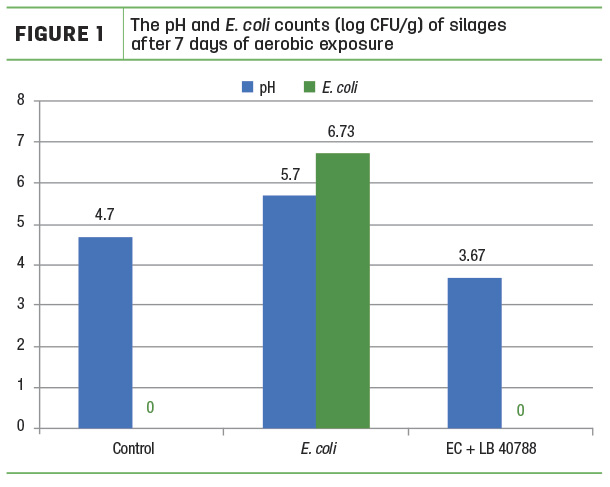Hauling away spoiled silage is no fun. There’s a sinking feeling that comes with throwing out feed. What’s even worse? Spoiled silage is not as rich in nutrients and contains detrimental microbes, along with their end products, which can undermine herd health and productivity.
Even crops properly harvested and ensiled with good overall management can be susceptible to undesirable fermentations and other bad microbial activity. Silage can appear to ferment well and then heat and spoil during feedout. When apparently well-preserved feed goes bad, it’s all down to the balance of microbes within the silage mass.
We recommend a four-pronged approach at silage harvest to help win the battle against spoilage microbes:
- Start with a forage crop harvested at the proper stage of maturity, moisture content and chop length.
- Stack the deck with a forage inoculant that adds efficient, research-proven lactic acid bacteria (LAB) according to your needs and objectives.
- Pack the forage tight to exclude oxygen, which is the worst enemy of the ensiling process.
- Cover and seal the structure to minimize ongoing oxygen exposure.
The goal with silage is to maximize preservation of the forage quality and retain nutrients present in the crops at the time of harvest. It is important to start with high-quality crops, as detailed in the first article in this series. In this article, let’s review how to maximize the efficiency of preservation and deliver the maximum amount of the highest-quality feed possible to your animals.
Dropping the pH (fast)
We need to eliminate residual oxygen to start the fermentation that will drop the pH of the forage mass. A low pH is needed to maintain stable, high-quality silage. It creates an environment that essentially “pickles” the forage and – coupled with lack of oxygen – helps prevent growth of spoilage microbes like clostridia, enterobacteria, yeasts and molds. A delay in this initial phase allows for extensive plant respiration and enzymatic activities, as well as allowing aerobic micro-organisms to continue to grow, degrading valuable nutrients and generating heat (Table 1).

Limiting amounts of soluble sugars, coupled with a low dry matter (DM) at ensiling creates ideal conditions for clostridia to take over the fermentation. Clostridia produce butyric acid, which smells bad and cause very high DM and nutrient losses. Some species can also produce toxic biogenic amines, which can lead to significant health and reproduction issues. Silage that is badly spoiled by clostridia can end up as a total loss, and any clostridial activity affects the ability to feed the silage. Including a homolactic forage inoculant proven to drive a fast, efficient fermentation can help control clostridial growth. Moreover, formulations with fibrolytic enzymes help generate sugars to drive the desired lactic fermentation in low-sugar crops.
1. Stacking the deck in your favor
Relying solely on the plants’ natural population of micro-organisms for the fermentation process is a risky decision. Even if the silage is not overtaken by clostridia, often the result is a prolonged fermentation with a slow rate of pH drop with nutrients and significant DM losses.
Adding a forage inoculant is often thought of as an insurance policy, but high-quality products can be a lot more. For instance, a top-quality product will contain a research-proven inoculant strain, or multiple strains, that can help maximize DM and nutrient retention – you can always make a good fermentation better. Plus, the inoculant may be proven to help improve aerobic stability to deliver stable, consistent, high-quality and palatable feed.
2. Packing, packing, packing
Once the forage is delivered to the storage structure, oxygen must be excluded from the forage mass before the active fermentative phase takes place. Packing the forage tight is one of the most important – and most overlooked – factors when making good silage.
Well-packed forage helps achieve an anaerobic environment, getting the fermentation started as quickly as possible to reduce DM losses. The minimum recommended packing density is 44 pounds per cubic foot on a fresh-weight basis or 15 pounds DM per cubic foot at 34% DM.
3. Covering and sealing
It is also imperative to properly cover and seal the ensiling structure as soon as possible. If not properly covered, storage losses can be extensive due to air exposure and the effects of the elements. Losses of around 80% in the top 10 inches of different ensiled forage crops that were not covered have been reported. Additionally, the resulting “crust” is expected to have high numbers of detrimental microbes and potential metabolites that negatively impact animal intake, production and health.
4. Reducing oxygen exposure at feedout
As silage is opened and fed out, it is once again exposed to air. Oxygen allows lactate-assimilating, spoilage yeasts to “wake up” and grow rapidly. These microbes use key nutrients in the silage, producing heat and CO2 (DM loss). Excessive heat can denature proteins and other nutrients in the silage. Because these yeasts use lactic acid for food, the pH rises, providing another opportunity for mold to grow on the silage and produce mycotoxins.
In addition, yeasts have been proven to reduce digestibility and feed intake (Table 2).

During feedout, common management practices that can limit yeast growth and help reduce losses include:
- Keeping the silage surface tight and clean
- Not removing silage too far ahead of feeding and not leaving it sitting in loose piles
- Feeding out at the correct rate
In most cases, aerobic instability and silage heating is caused by spoilage yeast growth, so all the management tips outlined above – and using proven inoculants at ensiling – will help.
Watching for mold growth
As the yeasts grow and raise the pH, molds and other opportunistic spoilage microbes (bacilli, listeria, enterobacteria, etc.) can begin to appear. By the time you see mold growth, aerobic spoilage is well advanced and significant losses have already occurred.
As the silage is fed, molds may be found in hot spots where there is air (oxygen) present. This is typically in poorly sealed surface layers, corners or shoulders of ensiled forages, or where pockets of air were trapped and packing was inadequate.
Mold growth can cause palatability issues and reduce animal performance. Plus, some molds can produce mycotoxins under certain circumstances.
“Mycotoxin” is a general term used for secondary metabolites, produced by some molds, which have been shown to have some associated toxicity issues. Mycotoxin production is often stimulated by stressors that occur while the plant is growing in the field, but some species (e.g., Fusarium spp.) come in on the crop from the field and have the potential to produce mycotoxins later.
Unstable, high-pH silages are susceptible not only to the regrowth of internal microbes but also to growth due to external contamination. Cattle feeds, including silage, have been shown to be a potential vector for growth and transmission of E. coli and salmonella species, for example when contaminated with manure or bird or rodent droppings. Researchers from the University of Florida studied corn silage re-inoculated with E. coli O157:H7 to simulate contamination with manure at feedout. Corn silage that had been inoculated with L. buchneri 40788 maintained a low pH and had undetectable counts of E. coli, while the pH of the untreated re-contaminated material increased, which allowed E. coli to grow (Figure 1).

Tasting great
The benefits of silage management to produce hygienic feeds add up: more feed, better nutritional quality and increased palatability. Many of the operations we work with report increased feed intake – and intake and quality drive production.








